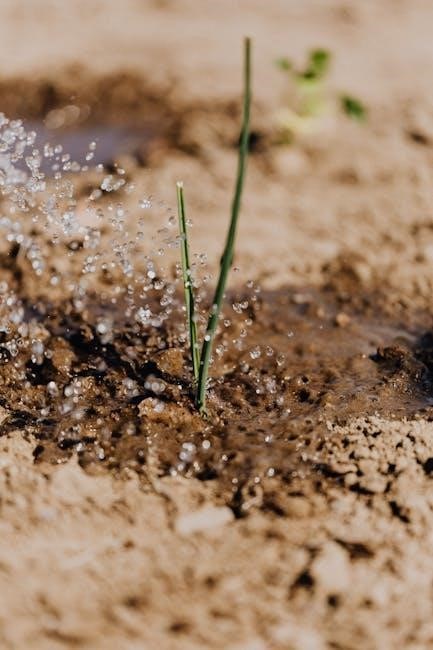The water cycle worksheet is an essential tool for understanding the continuous movement of water on Earth. It simplifies complex processes like evaporation, condensation, and precipitation, making learning engaging and interactive for students of all ages. By providing structured exercises and visual aids, these worksheets help learners grasp the water cycle’s significance in sustaining life and shaping our environment. They are a valuable resource for educators and students alike, offering a comprehensive and accessible way to explore this vital natural process.
1.1 Overview of the Water Cycle
The water cycle, also known as the hydrologic cycle, describes the continuous movement of water on, above, and below Earth’s surface. It involves processes like evaporation, condensation, precipitation, and transpiration, which connect oceans, atmosphere, land, and living organisms. This natural cycle sustains life and regulates Earth’s climate, ensuring water is distributed across the planet in a never-ending loop.
1.2 Importance of Worksheets in Learning
Worksheets are a valuable educational tool that enhances learning by providing structured activities tailored to specific topics. For the water cycle, worksheets offer interactive exercises like labeling diagrams, matching terms, and answering questions. They engage students actively, making complex concepts easier to understand. Worksheets also cater to different learning styles, ensuring a comprehensive grasp of the water cycle through visual and textual exercises.

Key Processes of the Water Cycle
The water cycle involves evaporation, condensation, precipitation, and transpiration. These processes describe how water moves between Earth and atmosphere, ensuring life-sustaining water distribution globally.
2.1 Evaporation
Evaporation is the initial process where water transforms from liquid to vapor, driven by solar energy. It occurs on surfaces like oceans, lakes, and rivers, and is crucial for water cycle continuity. This process is fundamental in worksheets, helping students visualize how water molecules rise into the atmosphere, forming the basis for subsequent processes like condensation and precipitation. It exemplifies the dynamic nature of Earth’s hydrological system.
2.2 Condensation
Condensation occurs when water vapor in the atmosphere cools and transforms back into liquid droplets, forming clouds, fog, or dew. This process is vital for precipitation and is often visualized in water cycle diagrams and labeling exercises. Worksheets help students understand how condensation contributes to cloud formation, emphasizing its role in the continuous movement of water between Earth and the atmosphere, a critical component of the hydrological cycle.
2.3 Precipitation
Precipitation occurs when water droplets in clouds become too heavy, falling to Earth as rain, snow, sleet, or hail. It is a crucial phase in the water cycle, replenishing Earth’s surface water. Worksheets often include diagrams and questions to explain this process, helping students understand how precipitation sustains ecosystems and influences weather patterns, making it a key topic in water cycle education and related activities.
2.4 Transpiration
Transpiration is the process by which plants release water vapor into the atmosphere through their leaves. It occurs mainly through stomata, tiny pores on leaf surfaces. This process is vital for plant growth and contributes to the water cycle by returning water to the atmosphere, where it can form clouds and eventually precipitation. Worksheets often include questions and diagrams to help students visualize and understand this key natural process in detail.

The Importance of Water Cycle Worksheets
Water cycle worksheets are vital for interactive learning, offering hands-on activities that enhance understanding of key processes like evaporation and condensation. They cater to diverse learning styles, ensuring students engage deeply with the material and retain knowledge effectively through structured exercises and visual aids.
3.1 Educational Benefits for Students
Water cycle worksheets provide students with a structured learning experience, enhancing their understanding of Earth’s hydrological processes. These resources cater to visual and kinesthetic learners through diagrams and labeling exercises, while short answer and multiple-choice questions reinforce retention. Worksheets also encourage critical thinking, allowing students to apply theoretical knowledge practically. This interactive approach fosters a deeper appreciation for environmental science and its real-world applications.
3.2 Enhancing Understanding Through Visual Aids
Visual aids in water cycle worksheets, such as diagrams, flowcharts, and labeling exercises, play a crucial role in simplifying complex concepts. These tools help students visualize processes like evaporation, condensation, and precipitation, making them easier to understand. Interactive elements, such as coloring or drawing, engage students and reinforce learning. By integrating visuals with answer keys, worksheets ensure clarity and provide immediate feedback, enhancing overall comprehension of the water cycle.
Types of Questions in Water Cycle Worksheets
Water cycle worksheets include multiple-choice, short-answer, and diagram-labeling questions. These formats cater to different learning styles and assessment needs, promoting engagement and understanding through diverse tasks.
4.1 Multiple Choice Questions
Multiple-choice questions in water cycle worksheets are designed to test foundational knowledge. They present several options, guiding students to identify correct processes like evaporation or condensation. This format helps assess understanding quickly and effectively, while also reinforcing key concepts through repetition and clear answers provided in the worksheet’s answer key. It’s an efficient way to evaluate learning outcomes.
4.2 Short Answer Questions
Short answer questions in water cycle worksheets encourage critical thinking and detailed explanations. Students describe processes like transpiration or precipitation, demonstrating their understanding. These questions allow for creativity and depth, while the provided answer key offers clear guidance. They are ideal for assessing comprehension and fostering a deeper connection to the material, making them a valuable component of educational resources.
Answer Key and Solutions
This section provides detailed step-by-step solutions to all questions, ensuring accuracy and clarity. The answer key helps students verify their responses and understand their mistakes, fostering better learning and teaching effectiveness.
5.1 Step-by-Step Solutions
These solutions guide students through each problem methodically. From labeling diagrams to explaining processes, answers are broken down to ensure clarity. For example, evaporation is detailed as water turning into vapor, entering the atmosphere. Each step is explained clearly, helping students understand the water cycle’s processes and improving their problem-solving skills effectively.
5.2 Common Mistakes to Avoid
Students often confuse evaporation with transpiration or mislabel precipitation stages. Mixing up condensation and accumulation is another frequent error. Additionally, some may overlook the role of groundwater in the cycle. To avoid these mistakes, carefully review definitions and ensure accurate diagram labeling. Double-checking answers and understanding each process’s unique role helps prevent common pitfalls and improves overall comprehension.
Where to Find Water Cycle Worksheets and Answers
Educational websites offer a variety of water cycle worksheets with answers in PDF format. Use specific search terms like “water cycle worksheet answers PDF” to find reliable resources quickly and efficiently for your learning needs.
6.1 Recommended Educational Websites
Several reputable educational websites offer high-quality water cycle worksheets with answers in PDF format. Popular platforms include Teachers Pay Teachers, Education.com, and ScienceLearningHub. These sites provide a wide range of resources, from labeled diagrams to interactive quizzes, catering to different grade levels and learning styles. Additionally, Google Classroom and PdfDrive are excellent sources for downloadable materials. Use specific search terms like “water cycle worksheet answers PDF” to find the most relevant resources quickly and efficiently.
6.2 Tips for Downloading PDF Resources
When downloading water cycle worksheet answers in PDF format, use specific search terms like “water cycle worksheet answers PDF” for quick results. Ensure the file format is PDF and preview content before downloading. Choose reputable websites to avoid malware. Use ad blockers for uninterrupted access. Save files with clear names for easy organization. Always verify that answer keys are included and accurate for educational purposes.

Visual Aids in Water Cycle Worksheets
Visual aids like diagrams, flowcharts, and labeling exercises enhance understanding of the water cycle. They provide a clear, interactive way for students to grasp complex processes visually.
7.1 Diagrams and Labeling Exercises
Diagrams and labeling exercises are crucial in water cycle worksheets, providing visual representations of processes like evaporation, condensation, and precipitation. These tools help students identify and understand key components, reinforcing vocabulary and concepts. Interactive labeling tasks engage learners, making complex processes accessible and memorable. By visually connecting terms to their functions, diagrams enhance comprehension and retention of the water cycle’s dynamics.
7.2 Flowcharts and Cycles
Flowcharts and cycles in water cycle worksheets provide a clear, step-by-step visualization of the process. They illustrate the continuous movement of water, from evaporation to precipitation, and its return to the Earth. These tools help students follow the sequence of events, understand the interconnections, and grasp the cyclical nature of the water cycle. Flowcharts also engage learners by breaking down complex concepts into manageable, visually organized steps.

Why Understanding the Water Cycle Matters
Understanding the water cycle is crucial for comprehending Earth’s climate, weather patterns, and ecosystems. It highlights water conservation’s role in sustaining life and natural resources, emphasizing its global impact.
8.1 Environmental Impact
The water cycle plays a vital role in shaping Earth’s environment. It influences climate, weather patterns, and ecosystems, ensuring water distribution across the planet. Evaporation, condensation, and precipitation regulate temperature and maintain biodiversity. Disruptions in this cycle can lead to droughts, floods, or habitat loss, underscoring its importance in environmental balance and sustainability. Understanding it helps address climate change impacts effectively.
8.2 Real-World Applications
The water cycle has practical applications in agriculture, urban planning, and meteorology. Understanding it helps predict weather patterns, manage water resources, and mitigate flood risks. Farmers rely on precipitation forecasts to plan planting and irrigation. Cities use water cycle data to design drainage systems and ensure water supply. It also informs renewable energy, like hydroelectric power, and supports ecosystem conservation, making it vital for sustainable development and environmental management strategies.
The water cycle worksheet is a valuable educational tool, helping students grasp the water cycle’s importance and processes. It fosters understanding, critical thinking, and practical application. By completing these exercises, learners gain essential skills in science and environmental awareness, encouraging a deeper appreciation for Earth’s water systems and their role in sustaining life.
9.1 Summary of Key Points
The water cycle worksheet is a comprehensive educational resource that simplifies complex processes like evaporation, condensation, and precipitation. It provides structured exercises, visual aids, and answer keys to enhance learning. By covering key concepts and real-world applications, these worksheets help students understand the water cycle’s role in sustaining life and shaping ecosystems. They are invaluable for fostering environmental awareness and scientific literacy in learners of all ages.
9.2 Encouragement for Further Learning
Exploring the water cycle through worksheets and answer keys sparks curiosity and deepens understanding. Encourage students to delve into real-world applications, such as climate patterns and water conservation. Suggest conducting experiments or researching local water systems to broaden their knowledge. Foster a love for environmental science by highlighting how the water cycle impacts daily life and global ecosystems, inspiring lifelong learning and stewardship.
